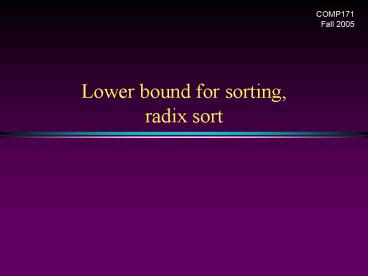Lower bound for sorting, radix sort - PowerPoint PPT Presentation
Title:
Lower bound for sorting, radix sort
Description:
possible orderings (e.g., the sorted output for a,b,c can be a b c, b a ... Can be bad if range is very big, e.g. M=O(N2) N=7, M = 9, Want to sort 8 1 9 5 2 6 3 ... – PowerPoint PPT presentation
Number of Views:79
Avg rating:3.0/5.0
Title: Lower bound for sorting, radix sort
1
Lower bound for sorting,radix sort
COMP171 Fall 2005
2
Lower Bound for Sorting
- Mergesort and heapsort
- worst-case running time is O(N log N)
- Are there better algorithms?
- Goal Prove that any sorting algorithm based on
only comparisons takes ?(N log N) comparisons in
the worst case (worse-case input) to sort N
elements.
3
Lower Bound for Sorting
- Suppose we want to sort N distinct elements
- How many possible orderings do we have for N
elements? - We can have N! possible orderings (e.g., the
sorted output for a,b,c can be a b c, b a c,
a c b, c a b, c b a, b c a.)
4
Lower Bound for Sorting
- Any comparison-based sorting process can be
represented as a binary decision tree. - Each node represents a set of possible orderings,
consistent with all the comparisons that have
been made - The tree edges are results of the comparisons
5
Decision tree for Algorithm X for sorting three
elements a, b, c
6
Lower Bound for Sorting
- A different algorithm would have a different
decision tree - Decision tree for Insertion Sort on 3 elements
7
Lower Bound for Sorting
- The worst-case number of comparisons used by the
sorting algorithm is equal to the depth of the
deepest leaf - The average number of comparisons used is equal
to the average depth of the leaves - A decision tree to sort N elements must have N!
leaves - a binary tree of depth d has at most 2d leaves
- ? the tree must have depth at least ?log2
(N!)? - Therefore, any sorting algorithm based on only
comparisons between elements requires at least - ? log2(N!) ? comparisons in the worst case.
8
Lower Bound for Sorting
- Any sorting algorithm based on comparisons
between elements requires ?(N log N) comparisons.
9
Linear time sorting
- Can we do better (linear time algorithm) if the
input has special structure (e.g., uniformly
distributed, every numbers can be represented by
d digits)? Yes. - Counting sort, radix sort
10
Counting Sort
- Assume N integers to be sorted, each is in the
range 1 to M. - Define an array B1..M, initialize all to 0 ?
O(M) - Scan through the input list Ai, insert Ai
into BAi ? O(N) - Scan B once, read out the nonzero integers ?
O(M) - Total time O(M N)
- if M is O(N), then total time is O(N)
- Can be bad if range is very big, e.g. MO(N2)
N7, M 9, Want to sort 8 1 9 5 2 6
3
5
8
9
3
6
1
2
Output 1 2 3 5 6 8 9
11
Counting sort
- What if we have duplicates?
- B is an array of pointers.
- Each position in the array has 2 pointers head
and tail. Tail points to the end of a linked
list, and head points to the beginning. - Aj is inserted at the end of the list BAj
- Again, Array B is sequentially traversed and each
nonempty list is printed out. - Time O(M N)
12
Counting sort
M 9, Wish to sort 8 5 1 5 9 5 6 2
7
1
2
5
6
7
8
9
5
5
Output 1 2 5 5 5 6 7 8 9
13
Radix Sort
- Extra information every integer can be
represented by at most k digits - d1d2dk where di are digits in base r
- d1 most significant digit
- dk least significant digit
14
Radix Sort
- Algorithm
- sort by the least significant digit first
(counting sort) - gt Numbers with the same digit go to same bin
- reorder all the numbers the numbers in bin 0
precede the numbers in bin 1, which precede the
numbers in bin 2, and so on - sort by the next least significant digit
- continue this process until the numbers have been
sorted on all k digits
15
Radix Sort
- Least-significant-digit-first
- Example 275, 087, 426, 061, 509, 170, 677, 503
16
(No Transcript)
17
Radix Sort
- Does it work?
- Clearly, if the most significant digit of a and b
are different and a lt b, then finally a comes
before b - If the most significant digit of a and b are the
same, and the second most significant digit of b
is less than that of a, then b comes before a.
18
Radix Sort
- Example 2 sorting cards
- 2 digits for each card d1d2
- d1 ???? base 4
- ? ? ? ? ? ? ?
- d2 A, 2, 3, ...J, Q, K base 13
- A ? 2 ? 3 ? ... ? J ? Q ? K
- ?2 ? ?2 ? ?5 ? ?K
19
// base 10
// FIFO
// d times of counting sort
// scan Ai, put into correct slot
// re-order back to original array
20
Radix Sort
- Increasing the base r decreases the number of
passes - Running time
- k passes over the numbers (i.e. k counting sorts,
with range being 0..r) - each pass takes O(Nr)
- total O(Nkrk)
- r and k are constants O(N)

